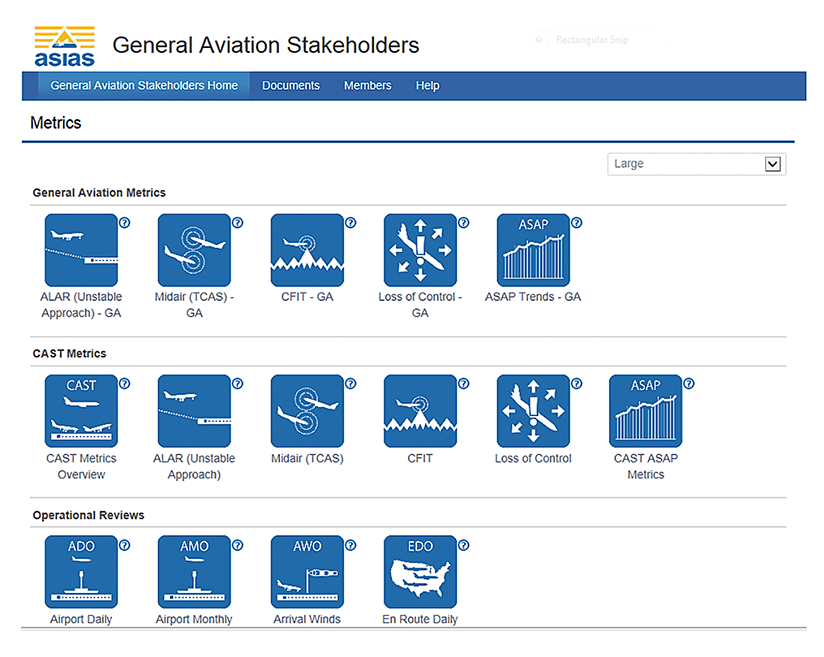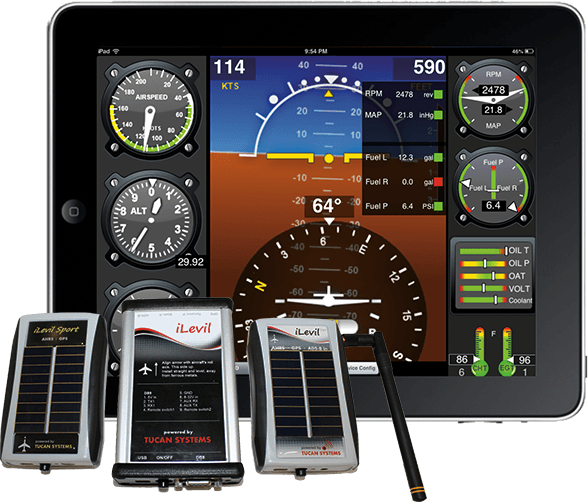
A growing number of business aviation operators, impressed by risk-mitigation methods that work extremely well for airlines, recently began joining the U.S. Federal Aviation Administration’s (FAA’s) Aviation Safety Information Analysis and Sharing (ASIAS) program as full-fledged members. Three leaders of an eight-month recruiting outreach say the willingness of these operators to take part in one of the world’s most advanced safety programs — at minimal cost and under tight security — can be traced back to routine flight data–aggregation groundwork laid about 15 years ago.1,2
Expanding the membership from this segment of general aviation — to 15 members as of August, compared with a total of 45 ASIAS-member airlines — is an essential part of an urgent push toward unprecedented safety data sharing for large-scale risk identification and risk mitigation, according to the leaders (ASW, 3/12).
 The outreach campaign clearly explains ASIAS benefits and member obligations, but in the process, the advocates encounter varying degrees of operator unfamiliarity, misconception, fear of data misuse and skepticism about the operator-level value of ASIAS, said Steve Charbonneau, member, ASIAS General Aviation Issues Analysis Team; chairman of the National Business Aviation Association (NBAA) Safety Committee; and senior manager, aviation training and standards, Altria Client Services. “There are questions about ‘What’s in it for me?’ ‘I don’t understand how it works.’ ‘What are the protections?’ ‘How do they work?’ And then finally, ‘What’s the outcome — if we’re going to expose our department’s flight data, what do we get out of it?’” he said.
The outreach campaign clearly explains ASIAS benefits and member obligations, but in the process, the advocates encounter varying degrees of operator unfamiliarity, misconception, fear of data misuse and skepticism about the operator-level value of ASIAS, said Steve Charbonneau, member, ASIAS General Aviation Issues Analysis Team; chairman of the National Business Aviation Association (NBAA) Safety Committee; and senior manager, aviation training and standards, Altria Client Services. “There are questions about ‘What’s in it for me?’ ‘I don’t understand how it works.’ ‘What are the protections?’ ‘How do they work?’ And then finally, ‘What’s the outcome — if we’re going to expose our department’s flight data, what do we get out of it?’” he said.
Typical U.S. business aviation operators, because of the limited scope of their operations, have a very small amount of data for safety teams to analyze, the leaders said. “If a business operator is flying 1,000 flights a year, that’s considered to be very high-tempo. And, realistically, extracting quality statistics from such a limited resource is difficult,” Charbonneau said. “Very few actually have the resources to bring in safety experts who are capable of doing this type of analysis.”
He cited six direct benefits for each member that joins ASIAS from the business aviation community: access to its secure Web portal and software dashboards, a deeper understanding by operators of their own issues, participation in government-industry InfoShare conferences that otherwise are closed to them, participation in and/or proposal of ASIAS directed studies, involvement at the outset in developing broad aviation industry safety enhancements, and representation in a systemic safety solution for business aviation.
Charbonneau rates the ability to attend the private, biannual InfoShare conferences, attended this year by about 800 industry and government representatives, as “probably the most outstanding part of this experience.” He describes each conference as a “fast-moving program where people get to present their issues and their solutions to issues. It gives us deep insight into what’s going on at the operator level.”
Business aviation operators just beginning to pursue flight operational quality assurance (FOQA)/flight data monitoring, voluntary nonpunitive reporting and other data-driven methods should not expect that the ASIAS program will substitute for their own safety management system, however. “ASIAS is a complementary part of an overall, systemic approach to safety, but it’s not meant to be an integral, all-encompassing safety program,” he said.
Two other outreach leaders are Corey Stephens, operations research analyst, FAA Office of Accident Investigation and Prevention, and Jeff Mittelman, ASIAS program senior principal engineer at MITRE’s Center for Advanced Aviation System Development (CAASD), an FAA-sponsored research and development center. They presented details of this effort during the FSF Business Aviation Safety Summit (BASS 2015) in May in Weston, Florida, U.S.
More specifically, as of August, this ASIAS outreach has led to enrollment not only of 15 corporate/business operators but also of one university and about 40 individual pilot-owners of aircraft. “The fleet is quite varied with 50-plus airframe models represented, all the major general aviation airframe manufacturers represented and aircraft operating under U.S. Federal Aviation Regulations Parts 91, 91K, 135 and 141. It’s dominated right now by corporate business jets — approximately 650,” Mittelman said. “There’s another 170 or so piston aircraft. The fleets range from one aircraft per operator to hundreds of aircraft for some of the operators.”
As of August, the ASIAS database from business aviation operators contained approximately 12,000 voluntary safety reports from aviation safety action programs (ASAPs) or ASAP-like (i.e., collected outside FAA-approved ASAP) programs, and FOQA data for approximately 17,000 flights submitted by the ASIAS general aviation members. By comparison, ASIAS data from the member airlines includes more than 10 times the number of ASAP reports and FOQA data from “many millions” of flights, he said. General aviation membership in ASIAS “is very small relative to the commercial program, but it’s building slowly and the more data we have, the better the results are. So that’s why we need people to join if they can,” Mittelman said.
Until the early 2000s, most operators of general aviation aircraft had no feasible method of routine data collection similar to FOQA, except typically those flying business jets with a data bus compatible with quick access recorder (QAR) technology. That has changed because of the data-sharing link between ASIAS and the National General Aviation Flight Information Database (NGAFID), a repository built in 2013 by the University of North Dakota in connection with an FAA center of excellence program.
CAST Legacy
Stephens describes ASIAS as a logical spinoff of the successful processes used by the government-industry Commercial Aviation Safety Team (CAST) to create effective and economically feasible safety enhancements that have gained worldwide acceptance largely through their basis in objective data analysis and airline implementation commitments. After reducing the fatality risk for commercial aviation in the United States by 83 percent from 1998 to 2008, the sentiment among CAST participants was, “We’ve got all the right resources and all the right people in the room with us; is there a way to continue that?” he recalled.
FOQA and ASAP programs established at air carriers in collaboration with the FAA gradually became the nucleus of an extensive networked “warehouse” of different types of safety data.
“ASIAS is truly looking for systemic issues. By bringing FOQA and ASAP data together and looking at ways to use those, we could start looking at ‘What are the next risks that could become the next fatal accident?’ It’s done as a community, and no single entity can go do it alone,” he said. “ASIAS enables authorized users to perform integrated queries” to proactively identify a safety issue — such as an airport’s increase in unstabilized approaches — as deemed appropriate by agreement of all members. Meanwhile, CAST continues to generate safety enhancements while working to achieve a 50 percent reduction in the 2010 risk level by 2025 (ASW, 12/11–1/12).
Stephens said that analysis of the data sources accessed through ASIAS helps the FAA determine whether risk mitigations recommended, for example, by the CAST’s or General Aviation Joint Steering Committee’s (GAJSC’s) safety enhancements or other safety guidance actually have the intended effect.
GAJSC, a topic–focused safety initiative launched in the late 1990s, adopted CAST methodology in 2011, including data-driven prioritization of needed safety-enhancements, described on the GAJSC website at <www.gajsc.org/safety-enhancements>. Today, GAJSC is an integral part of ASIAS, along with the executive governance under the ASIAS Executive Board, he said.
Two recent examples of ASIAS/GAJSC general aviation safety studies analyzed loss of control–in flight and system component failure–power plant. “Once everyone is happy with what we find, we develop something called a safety portfolio — mitigations that teams have formed/discovered, and that’s the safety plan for reducing fatal accidents or the risk of what could be the next fatal accident,” Stephens said.
Member Qualifications
Several key principles of ASIAS especially affect business aviation: strictly keeping all data secure under cooperation agreements and nondisclosure agreements, and balancing the interests of members, Stephens said.
“Truly, the data is used solely for the advancement of safety. It cannot be used for enforcement. It is a nonpunitive-reporting, collaborative approach. At the FAA, we cannot see operator-specific data. When we participate in a study group, we may be looking at issues that are in the data, but nothing can be done with it for enforcement or anything like that. Government and industry members all have a piece of the puzzle and once we bring all those pieces to the table and put them together, we see the complete picture,” he said. “We’ve had ASIAS members withdraw after mergers, we’ve had bankruptcies, but we’ve never had anyone leave ASIAS because of misuse of data. And that is something that we are very proud to say.”
Mittelman underscored the member obligations and protections when general aviation operators join ASIAS. “You have to join ASIAS to get the benefits of ASIAS but the data is confidential. It’s proprietary. It cannot be shared outside of ASIAS [without permission]. It’s only to be used for safety purposes not for commercial, competitive, punitive or litigation purposes,” he said.
Other highlights of ASIAS members’ obligations are that they cannot discuss or share information using any form of social media, and that safety issues/mitigations can be shared within member organizations “for the purpose of improving aviation safety.”
Stephens said that “it’s very easy to participate in ASIAS” for applicants already generating data for a FOQA, ASAP or related internal program. Determining a business aviation operator’s (or other interested entity’s) eligibility to join ASIAS at no cost depends on the applicant’s ability to participate, including submitting at least one type of relevant, deidentified safety data on an ongoing basis. Typically, members automatically submit their FOQA data, general aviation airborne recording device (GAARD) data, ASAP data, ASAP-like data or hybrids/combinations of these.
Behind the Scenes
MITRE — not FAA — signs the memorandum of understanding that officially enrolls every ASIAS member. Operators provide the data to MITRE, where it is securely stored and checked for data quality before it undergoes statistical analyses, data mining and integration with other data sources, he said. Since the FAA does not possess the data, there are no issues related to requests for ASIAS data submitted under the federal Freedom of Information Act, Mittelman added.
The ASIAS General Aviation Stakeholders page on the Web portal (Figure 1) becomes the primary medium for members to see the results of ASIAS analyses. “Only ASIAS members can see the data on the portal, and that is part of a strict governance,” Mittelman said.
Figure 1 — Home Page for Member-Only ASIAS Web Portal

ALAR = approach and landing accident reduction; ASAP = aviation safety action program; ASIAS = FAA Aviation Safety Information Analysis and Sharing Program; TCAS = traffic alert and collision avoidance system; CAST = Commercial Aviation Safety Team; CFIT = controlled flight into terrain; GA = general aviation
Notes: Selecting icons on this general aviation/business aviation–focused page of the secure ASIAS Web portal takes ASIAS members to software dashboards that enable viewing and/or creating customized, reusable queries of deidentified GA and airline data sources with metrics already analyzed by MITRE safety analysts.
Source: The MITRE Corporation
Low-Cost Technology

If an operator has aircraft equipped with avionics similar in capabilities to a Garmin G1000, routine flight data can be uploaded to NGAFID. “On the mobile device itself after your flight, you can get information about your flight. Once it’s uploaded in NGAFID, you can do analysis on the data. You can get more information about the flight. You can look at exceedances, you can replay flights and things like that,” Mittelman said.
Another possibility is for business aviation operators who cannot capture flight data with avionics to use GAARD for smartphones and tablet computers running the Apple iOS or Google Android mobile operating systems. GAARD wirelessly transfers and stores the flight data from a low-cost attitude and heading reference system installed on even the smallest aircraft, and also can securely upload deidentified flight data to NGAFID, and in turn to ASIAS.
“What we’ve found is that many operators in the corporate/business community and parts of the commercial community do not have any data-collection capability. The aircraft are too old, or they’re not equipped, or operators can’t afford to put QARs in them,” he said. “Based on the demand we have for this, we’re developing a fleet version using both the GAARD app and NGAFID, which will allow a safety manager to control multiple devices that might be used in multiple aircraft.”
Portal Benefit Details
Charbonneau explained that the ASIAS Web portal brings together in one user-friendly interface all of the program’s member-accessible data and analyses. “The portal content is aggregated and presented in a system of dashboards. Some dashboards focus on specific safety issues allowing you to take a deep dive into the concerns that you may want to research for your company,” he said. “The dashboards are organized into general aviation and commercial aviation metrics.”
This online access to otherwise restricted resources is called visibility to members. “We do have visibility on the commercial aviation metrics — so there is access to study those millions of FOQA flights, those hundreds of thousands of ASAP reports presently available for us to query,” Charbonneau said. “We also have visibility on operational reviews and comparative operator-to-industry FOQA data benchmarked in an aggregate way.” A second category of ASIAS data becomes visible to members through an evolving set of “vulnerability dashboards, which allow us to do some risk analysis,” he said. The dashboard for surveillance benchmarks, for example, includes FAA-collected data from every U.S. airport that has ASDE-X (airport surface detection equipment–model X).
One Member’s Experience
Recalling his own hands-on experience performing ASIAS-based research, Charbonneau described successes using a dashboard called the Airport Safety Event Metrics Overview. “About a year ago, I did a [runway-overrun] risk assessment of Chicago Midway Airport, and I was able to ascertain not only the issues but also which runways presented those issues.”
In ASIAS terminology, what a member or group of members would consider an industry-wide deep dive into a new issue — such as Charbonneau’s concern about possibly increased risk of midair collisions near Van Nuys (California, U.S.) Airport and Bob Hope (Burbank, California) Airport related to increased traffic at surrounding airports — is called a directed study. A total of 10 ASIAS directed studies have been completed in all ASIAS member categories, he said, noting, “One of the most recent ones surrounds RNAV SIDs and STARs [area navigation–based standard instrument departures and standard terminal arrivals] — a huge issue.” Launching a directed study, as noted, requires approval by the GAJSC and ASIAS Executive Board.
If approved, ASIAS analysts query all relevant databases, analyze results and publish the results on the portal. Lessons learned also may be disseminated as a GAJSC and/or CAST safety enhancement, or publication of FAA safety bulletins or other guidance to affected stakeholders.
Dissemination of Results
Charbonneau told ASW that the difference between ASIAS members using the portal’s dashboards versus pursuing a directed study is that “dashboards represent processed data that’s presented to be queried and presented to a member in a completely deidentified way. In directed studies, the working groups or teams get access to more of the raw data to craft or design or develop new ways to process data, ways to depict new dashboards and to gain new understandings and learnings from the data.” Every directed study seeks something different from what already has been presented by the dashboards, he added.
In practice, the confidential knowledge gained from directed studies and other analyses within closed ASIAS activities reaches the rest of the aviation community in one of several authorized ways. “The way that information can be shared from the ASIAS program that would be consistent with the intent of agreements would be through things like SAFOs [FAA Safety Alert for Operators], or through other CAST/GAJSC safety enhancements that are developed from the ASIAS program,” Charbonneau said, citing the FAA’s Nov. 25, 2014, issuance of SAFO 14005, which says its purpose is “to raise awareness of aircraft misconfigurations on takeoff with an emphasis on flap position.”
Speaking in his NBAA safety leadership role and calling on other business aviation leaders to encourage ASIAS participation, Charbonneau concluded: “I can’t overstate the importance of having a program like ASIAS to get laser-focused on the real issues. You can play a role by contributing your data, your information, into this program. This is a safe program. There’s never been a breach of protocol. Nobody’s left the program. And I’m here to tell you that I have faith that we can use this data to solve issues.”
Notes
- The outreach leaders credited work in the late 1990s by James M. Burin, then FSF director of technical programs; Edward D. (Ted) Mendenhall, a captain and then director of flight operations for Gulfstream Aerospace Corp.; and Robert H. Vandel, then FSF executive vice president, for leading a collaboration with the NBAA Safety Committee to develop and test flight data monitoring for business aircraft, currently called the Corporate Flight Operational Quality Assurance (C-FOQA) Centerline Program (ASW, 6/13).
- They said the C-FOQA Centerline program — and standalone counterparts such as CAE Flightscape, Aerobytes and Austin Digital — remains “a very important, vibrant” program for flight data monitoring within one company or a limited group of business aviation operators.
Featured image: © The MITRE Corporation
Pilot with tablet: © Avid Creative, Inc. | iStockphoto
Devices: © Levil Technology Corp.